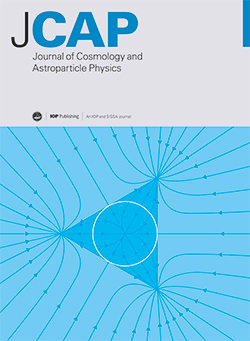Impact of radiative cooling on the magnetised geometrically thin accretion disc around Kerr black hole
IF 5.3
2区 物理与天体物理
Q1 ASTRONOMY & ASTROPHYSICS
Journal of Cosmology and Astroparticle Physics
Pub Date : 2025-01-31
DOI:10.1088/1475-7516/2025/01/152
引用次数: 0
Abstract
It is believed that the spectral state transitions of the outbursts in X-ray binaries (XRBs) are triggered by the rise of the mass accretion rate due to underlying disc instabilities. Recent observations found that characteristics of disc winds are probably connected with the different spectral states, but the theoretical underpinnings of it are highly ambiguous. To understand the correlation between disc winds and the dynamics of the accretion flow, we have performed General Relativistic Magneto-hydrodynamic (GRMHD) simulations of an axisymmetric thin accretion disc with different accretion rates and magnetic field strengths. Our simulations have shown that the dynamics and the temperature properties depend on both accretion rates and magnetic field strengths. We later found that these properties greatly influence spectral properties. We calculated the average coronal temperature for different simulation models, which is correlated with high-energy Compton emission. Our simulation models reveal that the average coronal temperature is anti-correlated with the accretion rates, which are correlated with the magnetic field strengths. We also found that the structured component of the disc winds (Blandford-Payne disc wind) predominates as the accretion rates and magnetic field strengths increase. In contrast, the turbulent component of the disc winds (Btor disc wind) predominates as the accretion rates and magnetic field strengths decrease. Our results suggest that the disc winds during an outburst in XRBs can only be understood if the magnetic field contribution varies over time (e.g., MAXI J1820+070).求助全文
约1分钟内获得全文
求助全文
来源期刊

Journal of Cosmology and Astroparticle Physics
地学天文-天文与天体物理
CiteScore
10.20
自引率
23.40%
发文量
632
审稿时长
1 months
期刊介绍:
Journal of Cosmology and Astroparticle Physics (JCAP) encompasses theoretical, observational and experimental areas as well as computation and simulation. The journal covers the latest developments in the theory of all fundamental interactions and their cosmological implications (e.g. M-theory and cosmology, brane cosmology). JCAP''s coverage also includes topics such as formation, dynamics and clustering of galaxies, pre-galactic star formation, x-ray astronomy, radio astronomy, gravitational lensing, active galactic nuclei, intergalactic and interstellar matter.
 求助内容:
求助内容: 应助结果提醒方式:
应助结果提醒方式:


